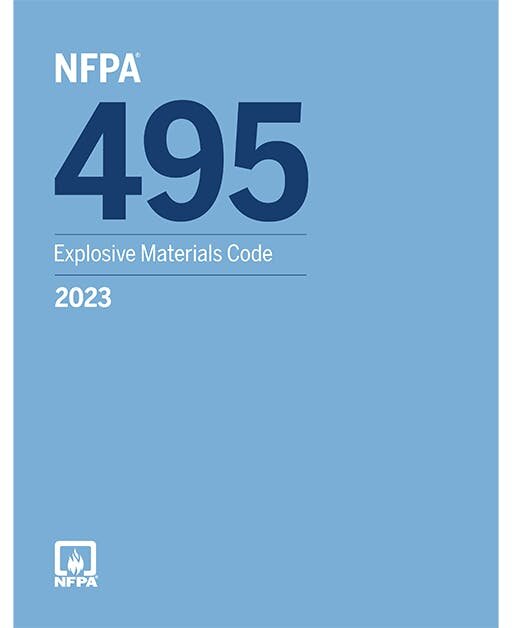NFPA 495 is the National Fire Protection Association’s (NFPA) standard for Explosive Materials. The full title is: NFPA 495: Explosive Materials Code.
This standard provides the requirements for the safe storage, handling, transportation, and use of explosive materials. It’s aimed at minimizing the risk of accidental explosions, injuries, and property damage, while allowing for the controlled use of explosive substances in industries such as construction, demolition, mining, fireworks manufacturing, and other activities where explosives are part of the work process.
Key Aspects of NFPA 495:
-
Classification of Explosives:
-
The standard outlines the classification of explosive materials into various groups based on their type, characteristics, and hazards.
-
Different explosive materials may be categorized by their sensitivity, type of hazard, and how they respond to external stimuli like heat, shock, or friction.
-
The classification also helps define storage, handling, and transport requirements based on the nature of the explosive.
-
-
Storage of Explosive Materials:
-
Specifies guidelines for the safe storage of explosive materials, including separation distances from other buildings, roads, and populated areas to minimize risk in case of an explosion.
-
Requirements are also outlined for ventilation, temperature control, and security (such as locked storage and restricted access).
-
Different storage scenarios (like outdoor versus indoor storage) are addressed, with specific guidelines for containers, construction, and security measures.
-
-
Transportation of Explosives:
-
NFPA 495 addresses the safe transportation of explosive materials, emphasizing requirements for vehicle types, security, and transport documentation.
-
It covers labeling and placarding for vehicles carrying explosives, as well as guidelines for emergency response during transport.
-
-
Handling and Use:
-
Requirements for the safe handling of explosive materials during use in industrial, construction, and mining applications are specified.
-
Guidelines for safe charging, blasting, and detonation processes, as well as the proper use of tools and equipment, are outlined to minimize the risk of mishandling.
-
Workers must be trained and equipped with personal protective equipment (PPE) when working with explosives.
-
-
Blasting Operations:
-
Specific provisions for blasting operations, including the use of blasting agents, detonators, and firing systems, are outlined.
-
Safety precautions during the use of explosives in mining, construction, demolition, and fireworks displays are emphasized.
-
-
Security Measures:
-
Explosive materials are high-risk, so the standard emphasizes security protocols to prevent theft, misuse, or sabotage.
-
Requirements include background checks for individuals handling explosives, security measures for storage sites, and surveillance requirements.
-
-
Facility Design:
-
The design of explosive storage facilities must meet certain criteria to reduce risk, such as blast-resistant construction, fire-resistant materials, and adequate emergency exits.
-
The layout and spacing of explosive materials within a facility are carefully regulated to reduce the risk of cross-contamination, accidental ignition, or chain reactions.
-
-
Emergency Procedures:
-
The standard includes guidance on emergency response in case of a fire, explosion, or accidental detonation, including the need for fire suppression systems, emergency exits, and response protocols.
-
Facilities must have well-defined evacuation plans and communication systems in place for emergencies involving explosives.
-
-
Maintenance and Inspection:
-
Regular inspections and maintenance of explosive storage and handling equipment are required to ensure that no safety hazards are present.
-
Testing of equipment like detonators or blasting systems is mandated.
-
-
Training and Certification:
-
Personnel working with explosives must be trained and, in many cases, certified to handle, store, and transport explosives safely.
-
Training programs should cover topics like safety procedures, emergency response, use of personal protective equipment (PPE), and regulatory compliance.
-
Importance of NFPA 495:
-
Safety: The core purpose of NFPA 495 is to protect workers, the public, and the environment from the hazards posed by explosive materials.
-
Regulatory Compliance: Many local and federal regulations (e.g., OSHA, DOT, ATF) require compliance with NFPA 495 for businesses that handle explosives.
-
Risk Reduction: By following the standards set forth in NFPA 495, companies can minimize the risk of accidental explosions, fires, and fatalities.
-
Best Practices: NFPA 495 provides a comprehensive framework of best practices, ensuring that all aspects of handling, storing, and using explosives are performed with safety in mind.
Applications:
-
Construction: Blasting operations for clearing land or demolishing structures.
-
Mining: Explosives used in excavation or mineral extraction.
-
Fireworks: Manufacturers and operators of fireworks displays.
-
Manufacturing: Industries where explosives are used in processes, such as ammunition production or pyrotechnics.
-
Military: Handling of explosives for defense-related activities.







